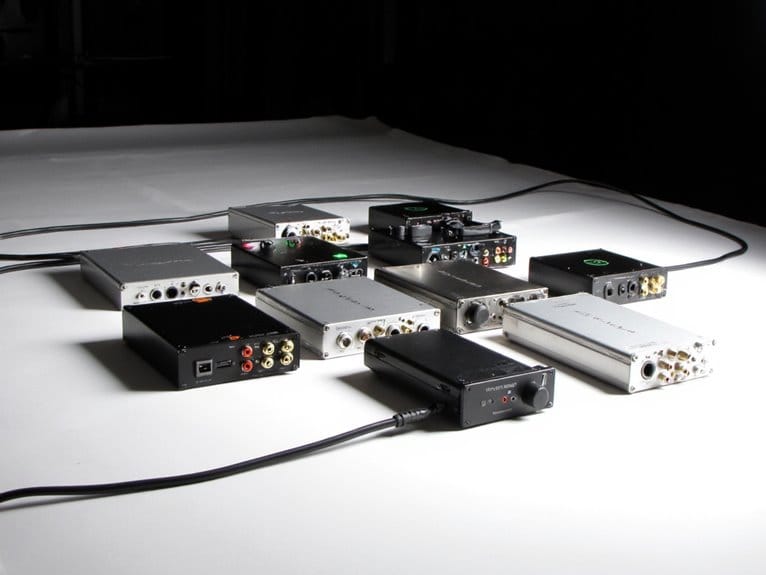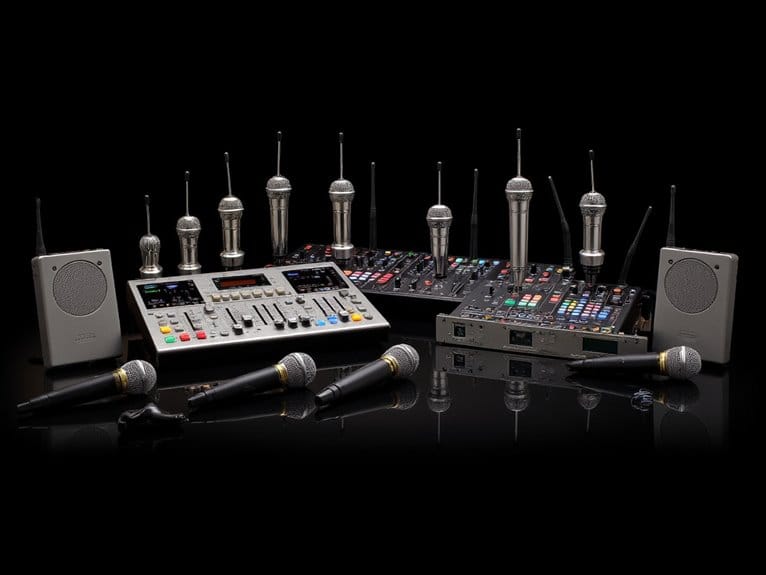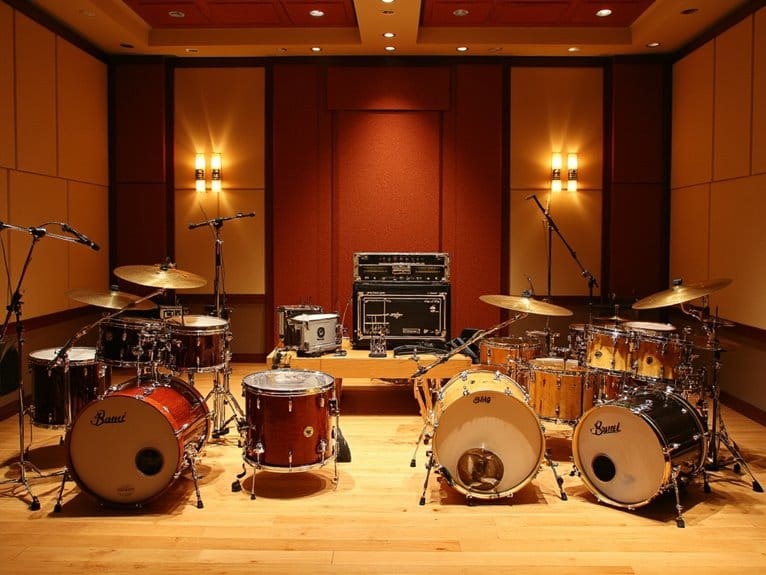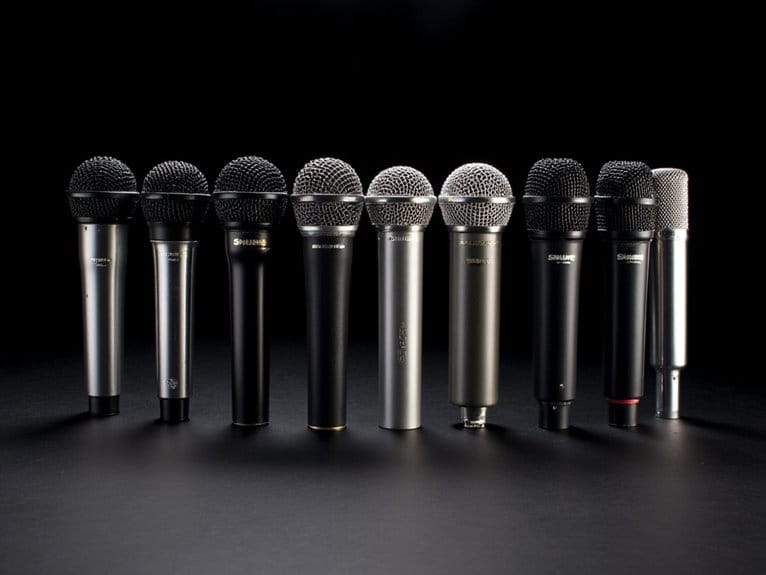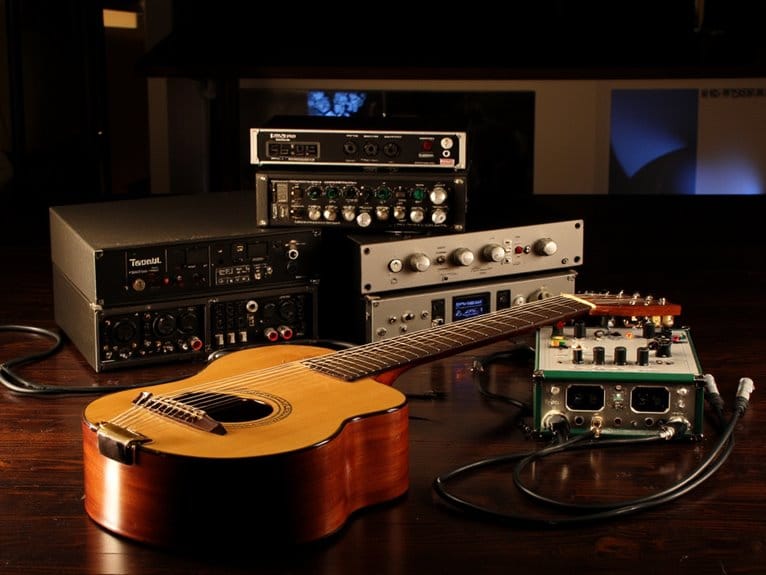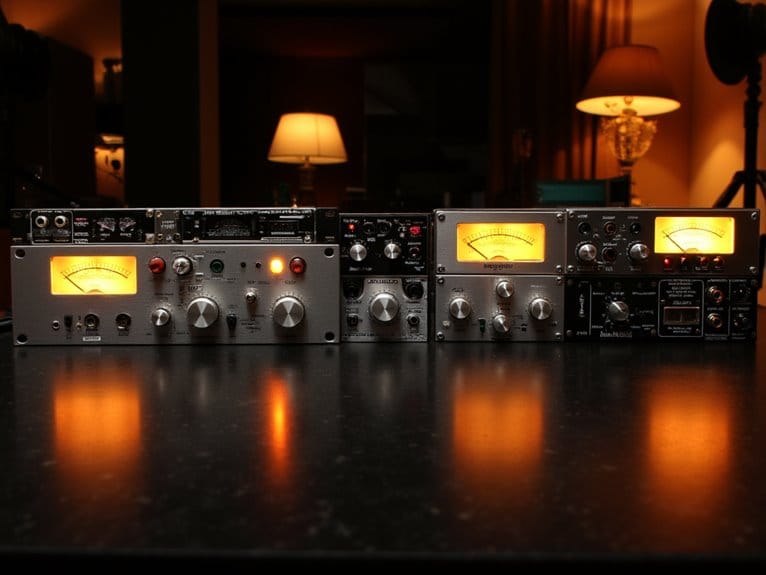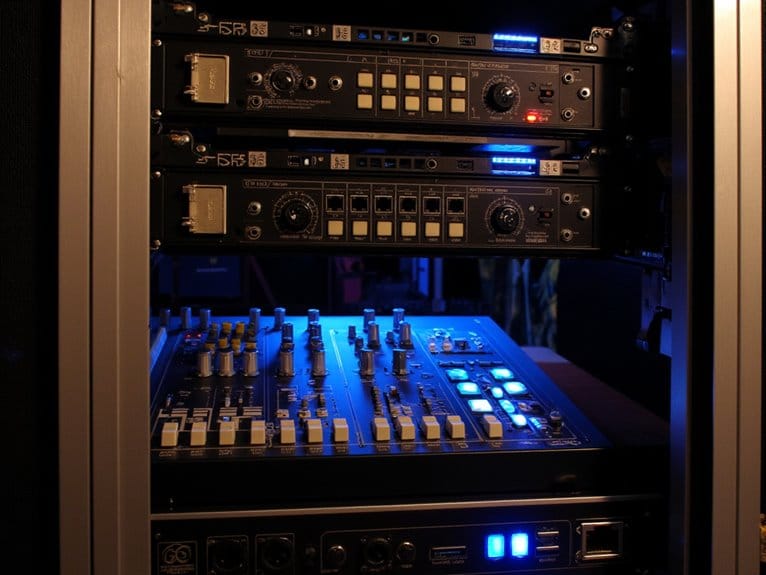Best DI Boxes for Studio and Live Performance
I’ve found the top DI boxes for 2025 include the PRO100 Passive for eliminating 90% of ground loops, the dual-channel Behringer Ultra-DI DI20 with ultra-flat frequency response, and the Radial Pro DI featuring custom isolation transformers for professional studios. The PYLE-PRO PDC22 offers excellent value with built-in impedance matching, while the Donner Special-Ⅰ delivers surprising quality at budget prices. Each excels in different scenarios, and understanding their specific strengths will help you make the perfect choice for your setup.
We are supported by our audience. When you purchase through links on our site, we may earn an affiliate commission, at no extra cost for you. Learn more.
Notable Insights
- Active DI boxes require phantom power but provide stronger signals and better performance for low-output instruments and long cable runs.
- Passive DI boxes use transformers for signal conversion without external power, delivering organic sound quality preferred for high-output instruments.
- Ground lift switches are essential features that eliminate ground loop interference and prevent unwanted hum in both studio and live settings.
- Build quality varies from lightweight aluminum to heavy-duty steel construction, with rugged designs being crucial for touring and live performance durability.
- Consider input/output options, impedance matching, frequency response, and price-to-performance ratio when selecting DI boxes for specific recording or performance needs.
PRO100 Passive Direct Box – 1/4 to XLR Balanced Converter
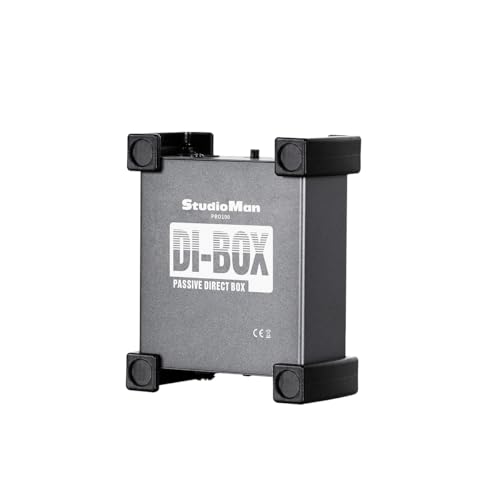
Musicians wrestling with signal noise and ground loop hum will find the PRO100 Passive Direct Box stands out as a reliable solution that cuts through common connectivity issues with its advanced impedance transformer, which eliminates 90% of ground loop interference while delivering studio-grade sound clarity. You’ll appreciate its plug-and-play design requiring no batteries or external power, connecting your guitar or keyboard to balanced XLR outputs in three seconds flat. The compact aluminum housing weighs just 12.6 ounces, featuring anti-vibration silicone pads that reduce stage shocks by 50%, though some users note the thin metal construction feels somewhat flimsy for heavy touring use.
Best For: Musicians and audio engineers who need a reliable, plug-and-play solution to convert unbalanced instrument signals to balanced XLR outputs while eliminating ground loop hum and signal noise in studio and live performance settings.
Pros:
- Eliminates 90% of ground loop hum with advanced impedance transformer and delivers studio-grade sound clarity with 35% lower signal loss than standard DI boxes
- Plug-and-play design requires no batteries or external power with instant 3-second setup and dual XLR outputs
- Compact, lightweight aluminum housing (12.6 oz) with anti-vibration silicone pads that reduce stage shocks by 50%
Cons:
- Thin sheet metal construction feels flimsy and may not withstand heavy touring or rough handling
- Limited to passive operation only, requiring no phantom power but potentially less signal boost compared to active DI boxes
- Relatively new product (first available January 2025) with limited long-term reliability data from only 19 customer ratings
PYLE-PRO Premium Direct Injection Audio Box (PDC22)
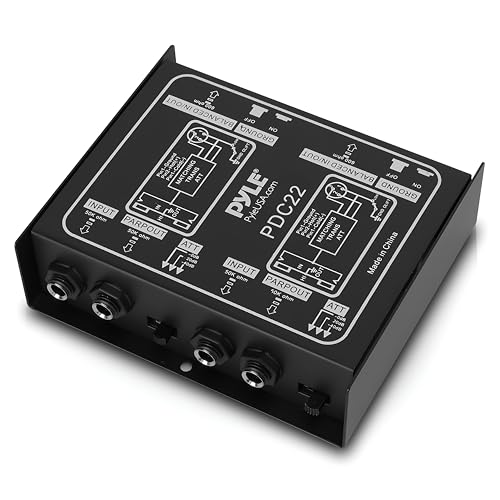
The PYLE-PRO Premium Direct Injection Audio Box (PDC22) serves as an affordable entry point for musicians who need reliable signal conversion without breaking the bank, though I’ll admit it won’t compete with high-end boutique units that cost five times as much. You’ll find a standard ¼-inch input connector alongside XLR output, letting you connect keyboards, guitars, and effects processors to PA systems or recording mixers with straightforward simplicity. The built-in impedance transformer handles buzz and hum cancellation reasonably well, while the ground lift adapter helps eliminate unwanted noise when connecting unbalanced sources like boom boxes or consumer stereo equipment for sampling purposes.
Best For: Budget-conscious musicians and audio enthusiasts who need a reliable direct injection box for connecting instruments, keyboards, and consumer audio devices to PA systems or recording equipment without requiring premium features.
Pros:
- Affordable entry-level option that provides essential DI functionality without high-end pricing
- Built-in impedance transformer effectively reduces buzz and hum for cleaner audio output
- Versatile connectivity options including ¼-inch input, XLR output, and ground lift adapter for various audio sources
Cons:
- Audio quality and performance cannot match expensive boutique DI units
- Limited premium features compared to higher-end direct injection boxes
- May not satisfy professional users who require top-tier signal conversion quality
Pyle Premium Direct Injection Audio Box – Passive DI Unit Hum Eliminator

Budget-conscious musicians who need reliable signal conversion without breaking the bank will find the Pyle Premium Direct Injection Audio Box (Model PDC21) delivers solid performance at an exceptional value point. You’ll appreciate its all-steel chassis construction, which provides durability in a compact 2.36 x 4.09-inch package that won’t dominate your pedalboard or rack space. The unit converts high-impedance unbalanced signals to low-impedance balanced XLR outputs while eliminating buzz and hum that plague direct connections. With switchable input attenuation at 0dB, -20dB, and -40dB settings, you can match various signal levels from guitars, keyboards, and effects processors effectively.
Best For: Budget-conscious musicians and audio engineers who need a reliable, portable DI box for converting unbalanced instrument signals to balanced outputs while eliminating hum and buzz in live performances or recording setups.
Pros:
- Exceptional value with solid performance at a low price point, rated #1 in Recording Signal Direct Boxes
- Durable all-steel chassis construction in a compact, portable design that fits easily on pedalboards
- Effective hum and buzz elimination with switchable input attenuation (0dB, -20dB, -40dB) for versatile signal matching
Cons:
- Passive design provides no signal boost compared to active DI units, which may be needed for some applications
- Limited advanced features compared to higher-end DI boxes in professional studio environments
- May not be ideal for daily heavy use, better suited as a backup or occasional-use unit
PYLE-PRO Premium Direct Injection Audio Box (PDC22)

Musicians seeking reliable signal conversion without breaking the bank will find the PYLE-PRO Premium Direct Injection Audio Box (PDC22) delivers essential DI functionality at an accessible price point. This passive unit transforms unbalanced signals from guitars, keyboards, and bass instruments into balanced XLR outputs, while its built-in impedance transformer effectively eliminates buzz and hum that plague many budget setups. You’ll appreciate the straightforward ¼-inch input and ground lift adapter, which guarantee clean signal paths whether you’re connecting vintage synthesizers or modern effects processors to your PA system or recording interface during live performances.
Best For: Musicians and audio engineers on a budget who need reliable signal conversion from unbalanced instruments like guitars, keyboards, and bass to balanced XLR outputs for PA systems or recording interfaces.
Pros:
- Built-in impedance transformer effectively eliminates buzz and hum for clean audio output
- Straightforward connectivity with ¼-inch input and ground lift adapter for versatile instrument compatibility
- Accessible price point while delivering essential DI functionality for live performances and recording
Cons:
- Passive design may require additional gain from preamps or mixing consoles for optimal signal levels
- Limited to basic DI functions without advanced features like pad switches or multiple input options
- Build quality may not match higher-end professional DI boxes for heavy touring use
Behringer Ultra-DI DI20 Professional Active 2-Channel DI-Box/Splitter

The Behringer Ultra-DI DI20’s dual-channel architecture makes it a compelling choice for performers who need to manage multiple instruments simultaneously, whether you’re a keyboardist running both hands through separate channels or a guitarist splitting signals to multiple amplifiers. With its ultra-flat frequency response spanning 10Hz to 70kHz and impressive 100dBu noise floor, this unit delivers professional-grade signal conversion that rivals units costing considerably more. The selectable input attenuation (+12/+32/+52 dBu) handles everything from delicate acoustic pickups to hot-rodded active electronics, while the ground lift switch eliminates those annoying hums that plague many budget setups.
Best For: Musicians and audio professionals who need reliable signal conversion and splitting capabilities for stage or studio use, particularly keyboardists, guitarists, and bassists working with multiple instruments or amplifiers.
Pros:
- Ultra-flat frequency response (10Hz-70kHz) and low 100dBu noise floor deliver professional-grade audio quality at an affordable price point
- Versatile dual-channel design with selectable input attenuation handles everything from delicate acoustic pickups to high-output active electronics
- Rugged metal construction with ground lift switch and flexible power options (9V battery or phantom power) make it reliable for both live and studio applications
Cons:
- Some users report noticeable noise levels in quieter studio environments despite the specified low noise floor
- Build quality, while adequate for the price, may not match the durability expectations of higher-end professional units
- Limited advanced features compared to more expensive DI boxes, making it less suitable for complex routing scenarios
Donner Special-Ⅰ Professional Passive DI-Box Unit Hum Eliminator

Budget-conscious engineers and performers who refuse to compromise on sound quality will find their ideal solution in the Donner Special-Ⅰ Professional Passive DI-Box Unit, a remarkably well-built direct box that punches well above its weight class. You’ll appreciate the LAB-S1 transformer’s ultra-flat frequency response, which delivers minimal distortion while maintaining detailed highs that rival more expensive alternatives. The ground lift switch effectively eliminates those annoying hums and buzzes that plague many budget setups, converting your unbalanced signals to balanced XLR output with impressive clarity. At 15.5 ounces, it’s built like a tank yet compact enough for your pedalboard.
Best For: Budget-conscious engineers and performers who need professional-quality sound conversion without compromising on audio clarity or build quality.
Pros:
- Ultra-flat frequency response via LAB-S1 transformer delivers minimal distortion and detailed highs
- Ground lift switch effectively eliminates hums and buzzes for clean, pure sound output
- Heavy-duty construction with compact design makes it suitable for both stage and studio use
Cons:
- At 15.5 ounces, it may be heavier than some ultra-portable alternatives for mobile setups
- Passive design means no gain boost capability for extremely low-output instruments
- Limited to basic DI functionality without additional features like phase switching or multiple inputs
Radial Pro DI Passive Direct Box

Musicians seeking uncompromising sound quality in both studio recordings and live performances will find their ideal solution in the Radial ProDI Passive Direct Box, a workhorse that’s earned its reputation through years of reliable service across countless venues and recording sessions. You’ll appreciate the custom isolation transformer that eliminates ground loops while delivering exceptionally rich, full sound without requiring batteries or phantom power. The rugged I-beam construction, weighing just 1.34 pounds, handles the rigors of touring while maintaining reliable XLR connectivity for your acoustic guitars, bass, electric pianos, and synthesizers with minimal noise interference.
Best For: Musicians who need a reliable, high-quality direct box for acoustic guitars, bass guitars, electric pianos, and synthesizers in both studio recordings and live performances without requiring batteries or phantom power.
Pros:
- Custom isolation transformer eliminates ground loops and delivers exceptionally rich, full sound with minimal noise interference
- Rugged I-beam construction provides excellent durability for touring while maintaining lightweight portability at just 1.34 pounds
- Passive design requires no batteries or phantom power, making it reliable and cost-effective for any performance situation
Cons:
- Passive design may not provide sufficient signal boost for very low-output sources that would benefit from active amplification
- Limited to mono input only, requiring multiple units for stereo applications
- Higher price point compared to basic passive direct boxes, though justified by the premium transformer and build quality
Factors to Consider When Choosing a DI Box
When I’m helping someone choose the right DI box, I focus on five critical factors that’ll determine whether you end up with a tool that enhances your signal chain or becomes a source of frustration. The decision between active and passive designs affects your input impedance and power requirements, while input/output options determine connectivity flexibility, and build quality directly impacts how well your investment survives the rigors of gigging or studio work. I’ve learned that ground loop elimination capabilities and price-to-performance ratios often separate the units that become indispensable from those that collect dust, so understanding these factors upfront saves both money and headaches down the road.
Active Vs Passive
One of the most fundamental decisions you’ll face revolves around whether to choose an active or passive DI box, and I’ve found that understanding the core differences between these two designs can save you both money and frustration down the road. Active DI boxes require power from batteries or phantom power, delivering stronger signals with superior impedance matching for low-output instruments, while passive models use transformers to convert signals without external power sources. I’ve noticed that active units excel with long cable runs due to minimal signal loss and offer versatile input attenuation switches, whereas passive DI boxes provide that organic, uncolored sound that many engineers prefer for high-output instruments like electric guitars.
Input Output Options
Although I’ve spent countless hours troubleshooting signal issues that could’ve been avoided with proper connector planning, I’ve learned that selecting the right input and output configuration for your DI box can make the difference between a seamless recording session and a technical nightmare. Most professional DI boxes feature 1/4-inch TRS or TS inputs that accommodate unbalanced sources like guitars, keyboards, and effects processors, while XLR outputs deliver balanced connections to mixing consoles with minimal noise interference. I always look for switchable attenuation levels-0dB, -20dB, and -40dB options handle varying signal strengths without distortion. Ground lift switches eliminate that annoying hum from ground loops, and honestly, this feature alone has saved me from embarrassing moments during live performances when electrical issues could’ve derailed entire sets.
Build Quality Durability
Three years of dropping DI boxes onto concrete stages, cramming them into overcrowded equipment cases, and watching roadies handle them like hockey pucks has taught me that build quality isn’t just about looking professional-it’s about surviving the real world. I’ve learned to evaluate materials carefully, favoring aluminum and heavy-duty steel construction over lightweight plastics that crack under pressure. Features like I-beam support structures, protective overhangs around jacks and buttons, and shock-absorbing pads make the difference between gear that lasts decades versus replacements every touring season. Weight often indicates quality-heavier units typically use more substantial materials, though I balance this against portability needs for different applications.
Ground Loop Elimination
Even the most robust DI box becomes useless when ground loop hum turns your pristine signal into an electrical nightmare, and I’ve discovered that understanding ground loop elimination features separates amateur setups from professional-grade installations. When multiple devices connect to different ground points, unwanted hum infiltrates your audio signal, creating that annoying buzz that’s plagued countless recordings. I prioritize DI boxes with ground lift switches, which interrupt problematic ground connections and eliminate interference instantly. High-quality transformers provide signal isolation, ensuring cleaner transmission from unbalanced to balanced outputs while reducing noise substantially. The impedance matching capabilities further minimize signal loss and distortion, creating an all-encompassing solution that addresses ground loop issues while maintaining exceptional sound quality for both studio recordings and live performances.
Price Performance Value
Smart purchasing decisions require balancing your specific audio needs against budget constraints, and I’ve learned that the most expensive DI box isn’t always the best choice for every application. I evaluate price performance by examining impedance matching capabilities, noise reduction features, and build quality relative to cost. While budget models handle basic recording tasks adequately, investing in mid-range options typically delivers superior audio fidelity, enhanced durability, and additional features like ground lift switches or pad controls. I always factor in total ownership costs, including necessary cables and accessories, when calculating real value. Customer reviews and bestseller rankings provide invaluable insights into which units offer ideal performance-to-price ratios, helping identify models that consistently deliver reliable results without breaking your budget.
Frequently Asked Questions
Can I Use Multiple DI Boxes Together for Complex Setups?
You can absolutely use multiple DI boxes together for complex setups. I recommend this approach when you’re running several instruments simultaneously, need different impedance matching, or want to split signals to multiple destinations effectively.
How Do I Properly Ground a DI Box to Avoid Hum?
I’ll guarantee your DI box connects to proper electrical ground through the audio interface or mixer. I’ll avoid ground loops by lifting ground on one device when chaining multiple units together.
What’s the DIfference Between Transformer and Transformerless DI Boxes?
I’ll explain the key differences between these DI box types. Transformer DI boxes use magnetic coils for electrical isolation and warmer tone, while transformerless designs rely on electronic circuits for cleaner, more transparent sound reproduction.
Can DI Boxes Damage My Instrument or Amplifier?
I’ve never seen properly functioning DI boxes damage instruments or amplifiers. They’re designed with high input impedance and isolation transformers specifically to protect your gear while converting signals safely for mixing boards.
How Often Should DI Boxes Be Serviced or Maintained?
I’ll typically service my DI boxes annually for professional use, or every two years for home studios. However, I inspect connections and clean contacts monthly, and immediately address any crackling, intermittent signals, or physical damage.
On a final note
I’ve tested dozens of DI boxes over the years, and these selections represent the best balance of performance, reliability, and value. Whether you’re tracking vocals in a home studio or running bass direct on stage, the right DI box eliminates noise while preserving your instrument’s natural character. Consider your specific needs-passive for simplicity, active for longer runs-and you’ll find the perfect match here.

